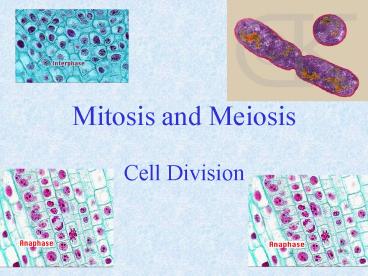Mitosis and Meiosis - PowerPoint PPT Presentation
1 / 46
Title:
Mitosis and Meiosis
Description:
Mitosis and Meiosis Cell Division Prophase I Chromosomes condense Homologous chromosomes pair w/ each other Each pair contains four sister chromatids - tetrad ... – PowerPoint PPT presentation
Number of Views:835
Avg rating:3.0/5.0
Title: Mitosis and Meiosis
1
Mitosis and Meiosis
- Cell Division
2
Why Do Cells Divide?For growth, repair, and
reproduction
- http//www.luc.edu/depts/biology/dev/regen2.htm
3
Mitosis
- Organisms grow by the addition of cells
- In multicellular organism some of these cells
perform functions different from other cells.
4
- The process of a cell becoming different is
differentiation. - Under normal conditions once an animal cell
becomes specialized it can no longer form an
entire organism, however plant cells are
totipotent and any cell can form an entire plant.
5
When do cells divide?
- Most limiting factor in size is the size of the
cell membrane. - Cells must obtain nutrients
- as volume increases, cell surface area does not
increase as greatly - larger cells require a larger surface area for
survival
6
Cell Division vs. Nuclear Division
- Cytokinesis The actual division of the cell
into two new cells. - Mitosis The division of the nucleus of the cell
into two new nuclei. - Note Sometimes cells go through mitosis without
going through cytokinesis. Describe a cell that
did this.
7
Terminology
- Chromatin - thin fibrous form of DNA and proteins
- Sister chromatids- identical structures that
result from chromosome replication, formed during
S phase
8
Anatomy of a Chromosome
p -arm
- Centromere - point where sister chromatids are
joined together - Pshort arm upward
- Qlong arm downward
- Telomere-tips of chromosome
centromere
q-arm
telomere
chromatids
9
10
How Do Cells Divide?
- Cell cycle - sequence of phases in the life cycle
of the cell
11
Getting ready to split
- Cell cycle has two parts
- growth and preparation (interphase)
- cell division
- mitosis (nuclear division)
- cytokinesis (cytoplasm division)
12
Interphase
- Occurs between divisions
- Longest part of cycle
- 3 stages
13
(No Transcript)
14
Interphase
- G1 or Gap 1
- The cell just finished dividing so in Gap 1 the
cell is recovering from mitosis
15
Interphase
- S or Synthesis stage
- DNA replicates
16
Interphase
- G 2 or Gap 2
- This is preparation for mitosis
- Organelles are replicated.
- More growth occurs.
17
(No Transcript)
18
MITOSIS Mitosis begins after G 2 and ends before
G 1
19
Prophase
- Chromosome condense
- Microtubles form
- The nuclear envelope breaks down
20
Metaphase
- Chromosomes are pulled to center of cell
- Line up along metaphase plate
21
(No Transcript)
22
Anaphase
- Centromeres divide
- Spindle fibers pull one set of chromosomes to
each pole - Precise alignment is critical to division
23
(No Transcript)
24
Telophase
- Nuclear envelope form around chromosomes
- Chromosomes uncoil
- Cytokinesis
- animals - pinching of plasma membrane
- plants- elongates and the cell plate forms(
future cellwall and cell membrane)
25
http//www.sci.sdsu.edu/multimedia/mitosis/
26
Meiosis
27
What is Meiosis?
- A division of the nucleus that reduces chromosome
number by half. - Important in sexual reproduction
- Involves combining the genetic information of one
parent with that of the the other parent to
produce a genetically distinct individual
28
Terminology
- Diploid - two sets of chromosomes (2n), in humans
23 pairs or 46 total - Haploid - one set of chromosomes (n) - gametes or
sex cells, in humans 23 chromosomes
29
Chromosome Pairing
- Homologous pair
- each chromosome in pair are identical to the
other ( carry genes for same trait) - only one pair differs - sex chromosomes X or Y
30
Phases of Meiosis
- A diploid cell replicates its chromosomes
- Two stages of meiosis
- Meiosis I and Meiosis II
- Only 1 replication
31
(No Transcript)
32
- Synapsis - pairing of homologous chromosomes
forming a tetrad. - Crossing over - chromatids of tetrad exchange
parts.
33
Meiosis I
34
Prophase I
- Chromosomes condense
- Homologous chromosomes pair w/ each other
- Each pair contains four sister chromatids - tetrad
35
Metaphase I
- Tetrads or homologous chromosomes move to center
of cell
36
Anaphase I
- Homologous chromosomes pulled to opposite poles
37
Telophase I
- Daughter nuclei formed
- These are haploid (1n)
38
Meiosis II
- Daughter cells undergo a second division much
like mitosis - NO ADDITIONAL REPLICATION OCCURS
39
Prophase II
- Spindle fibers form again
40
Metaphase II
- Sister chromatids move to the center
41
Anaphase II
- Centromeres split
- Individual chromosomes are pulled to poles
42
Telophase II Cytokinesis
- Four haploid daughter cells results from one
original diploid cell
43
http//www4.ncsu.edu/unity/users/b/bnchorle/www/in
dex.htm
44
Review Mitosis Meiosis
- Both are forms of nuclear division
- Both involve replication
- Both involve disappearance of the nucleus, and
nucleolus, nuclear membrane - Both involve formation of spindle fibers
45
DIFFERENCES
- Meiosis produces daughter cells that have 1/2 the
number of chromosomes as the parent. Go from 2n
to 1n. - Daughter cells produced by meiosis are not
genetically identical to one another. - In meiosis cell division takes place twice but
replication occurs only once.
46
Value of Variation
- Variation - differences between members of a
population. - Meiosis results in random separation of
chromosomes in gametes. - Causes diverse populations that over time can be
stronger for survival.































